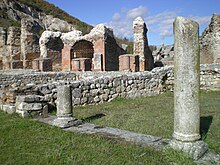Amiternum
Coordinates: 42 ° 24 ′ 2 ″ N , 13 ° 18 ′ 22 ″ E
Amiternum was an ancient city of the Sabines in Italy .
location
Amiternum was in Abruzzo at the foot of the Gran Sasso , on the site of today's San Vittorino part of the city of L'Aquila . The greater part of the city extended below a hill with a citadel on the Aternus River, after which the city was named. According to a milestone, the distance to Rome was 83 Roman miles (about 125 km). Amiternum was an important crossing point of the Via Caecilia , the Via Claudia Nova and two branches of the Via Salaria .
history
Amiternum, more precisely the nearby Testruna, was considered to be the origin of the Sabine people. 293 BC The Romans conquered the city from the Samnites and administered it as praefectura . Since the 2nd century BC Amiternum was completely Romanized and belonged to the Quirina tribe . 86 BC The historian Gaius Sallustius Crispus was born there. According to a later local legend, Pontius Pilatus also came from Amiternum.
The city still flourished in the imperial era and became the seat of a bishop. Their population is estimated at 20,000 to 25,000. A severe earthquake in 346 AD initiated the decline. The city was not abandoned until the Middle Ages around 1250; the residents moved to L'Aquila, about 8 km away, which also took over the bishopric. The diocese continues as the titular Amiternum of the Roman Catholic Church.
archeology
Numerous excavations have been carried out in the valley below San Vittorino since the late 19th century. To the north of the village, to the right of the SS 80, are the remains of a theater with perhaps Augustan masonry. It had a diameter of 80 m and could hold around 2000 spectators. While the rows of seats in the cavea have been partially restored, only the foundations of the scaena are visible. Outside the ancient city on the other side of the Aterno is the amphitheater , with a diameter of 68 m. It is a brick building from the first century AD that could seat 6,000 spectators. There are also remains of a thermal bath and perhaps a Tiberian aqueduct .
The most famous inscription found in the city is a calendar, the fasti Amiterni .
After a long standstill in Amiternum's archaeological research, intensive investigations are now taking place again. Since 2006, a project funded by the Swiss National Science Foundation at the University of Bern (since 2008 University of Cologne ) has been investigating the city by means of remote sensing, geophysical prospecting and targeted stratigraphic excavations. New evidence were u. a. the forum with basilica, a large domus of the local upper class and several sanctuary complexes. In 2007 and 2008 the regional monument authority of the province of Abruzzo undertook its own excavations at the theater and at a temple east of the amphitheater.
S. Michele
In the village of San Vittorino is the Romanesque church of S. Michele with frescoes from the 13th century. The catacombs are of particular interest . A staircase leads from the right aisle to the graves of more than 80 alleged martyrs, dating back to the 4th century. A grave is marked as a resting place of the Holy Victorinus (San Vittorino), the one of the first bishops of Amiternum with Kaiser Nerva the ordeal to have suffered. The system consists of quasi-natural caves and shafts, e.g. But partly also from column-supported vaults. There have been various interventions here and a wealth of legends has developed over the centuries about this tomb and its dead.
literature
- Michael Heinzelmann , D. Jordan: A Sabine-Roman country town in the upper Aterno valley . In: Booklets of the Archaeological Seminar of the University of Bern 20, 2007, pp. 79–92.
- Christian Hülsen : Amiternum . In: Paulys Realencyclopadie der classischen Antiquity Science (RE). Volume I, 2, Stuttgart 1894, Col. 1840 f.
- Alessandro Mucciante: Amiternum (AQ), loc. San Vittorino: le indagini nell'area del Teatro . In: Quaderni di Archeologia d'Abruzzo , 4 (2012), Florenz 2016, pp. 133-143.
- Gerhard Radke : Amiternum. In: The Little Pauly (KlP). Volume 1, Stuttgart 1964, Col. 301.
- Edward Togo Salmon: Amiternum (San Vittorino) Latium, Italy . In: Richard Stillwell et al. a. (Ed.): The Princeton Encyclopedia of Classical Sites. Princeton University Press, Princeton NJ 1976, ISBN 0-691-03542-3 .
- S. Segenni: Amiternum e il suo territorio in età romana . Giardini Editori, Pisa 1985.
- Roger Willemsen : The Abruzzo. The mountains in the heart of Italy. Art, culture and history . DuMont, Cologne 1990, ISBN 3-7701-2256-9 , p. 154.
Web links
- University of Bern, Archaeological Institute
- University of Cologne, Archaeological Institute
- Monument Authority (Italian)
- Excavations Amiternum (Italian)
Remarks
- ↑ CIL 9, 5957 .
- ^ So Gerhard Radke: Amiternum. In: The Little Pauly (KlP). Volume 1, Stuttgart 1964, Col. 301. On the other hand, ET Salmon, Amiternum , in: Princeton Encyclopedia of Classical Sites , 1976, assumes that the 293 BC. Amiternum conquered a city of the same name in northwestern Samnium.
- ^ Archeologia Aquilana ( Memento of October 7, 2007 in the Internet Archive ). Retrieved October 19, 2015.
- ↑ Aquila TV ( page no longer available , search in web archives ) Info: The link was automatically marked as defective. Please check the link according to the instructions and then remove this notice. .
- ↑ il centro, July 5, 2008 ( Memento of the original from August 1, 2008 in the Internet Archive ) Info: The archive link was inserted automatically and has not yet been checked. Please check the original and archive link according to the instructions and then remove this notice. .


